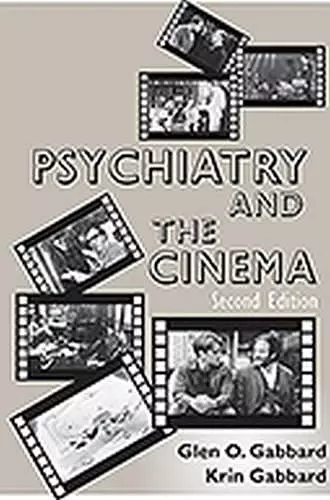Psychiatry and the Cinema
Glen O Gabbard author Krin Gabbard author
Format:Paperback
Publisher:American Psychiatric Association Publishing
Published:30th Apr '99
Currently unavailable, our supplier has not provided us a restock date

Psychiatry and cinema arrive at the same historical juncture to put a new spin on human dreams--indeed, the critic Parker Tyler once called the movie-house the psychoanalytic clinic of the average worker. This invaluable and insightful book, now in a welcome second edition, illuminates the ways in which that glamorous clinic chose to represent the activities of its soulmate and rival. J. Hoberman, Film Critic, The Village Voice, New York, New York The love hate relationship between the cinema and psychiatry and psychoanalysis continues unabated. For this second edition of Psychiatry and the Cinema, published eleven years after the first, Glen and Krin Gabbard have added close to 150 films to their filmography. Lively and informative the book sets out a feast in word and pictures for film buffs, mental health professionals and those of us who are both. If there was an Academy Award for a book on film, Psychiatry and the Cinema would be the winner, hands down. Arnold Richards, M.D., Editor, Journal of the American Psychoanalytic Association, New York, New York The second edition of Psychiatry and the Cinema is a welcome addition to the literature. This important study of both psychiatrists in movies and applying psychoanalytic critical methods to movies has been updated to include recent films and recent theory. The results are impressive, necessary reading for anyone interested in these fascinating topics. Peter Lehman, Director of Graduate Studies, Department of Media Arts, University of Arizona, Tucson, Arizona This extraordinary book is simultaneously erudite, comprehensive, amusing, and fascinating. The authors provide a deep description of the interaction of movies and psychiatry, and they demonstrate the sophisticated use of psychiatric and psychoanalytic scholarship in approaching another discipline. It is not the least of this book's virtues that the writing is clear, and ideas are presented without obfuscation. The readers will learn a tremendous amount about the place of psychiatry in American movies and culture, and they will have as much fun as they would if they went to the movies. Arnold M. Cooper, M.D., Deputy Editor, American Journal of Psychiatry, Editor for North Amer, Intl Journal of Psychoanalysis, Prof Emeritus in Consultation-Liaison Psychiatry, Cornell Univ Med Coll
Psychiatry and the Cinema explores this complementary relationship from two angles, psychiatrists who have studied the movies and movies that have depicted psychiatry. This second edition has updated this definitive text with a discussion of new trends in psychoanalytically oriented film theory, and an expanded list of movies is analyzed.
Early in the history of cinema, psychiatrists studied the movies to understand their appeal and power. Meanwhile, filmmakers have long been intrigued by psychiatry and frequently portray this mysterious world in film. Both movies and psychiatry focus on human thought, emotions, behavior, and motivation—making a link between the two subjects inevitable.
Psychiatry and the Cinema explores this complementary relationship from two angles, psychiatrists who have studied the movies and movies that have depicted psychiatry. This second edition looks at:
• Over 400 theatrically-released American films that feature psychiatrists or other mental health professionals at work
• The stereotypical characters and conventions dominating the presentation of movie psychiatrists and the historical rise and fall of the psychotherapist image in the movies
• New trends in psychoanalytically oriented film theory
• State-of-the-art understanding of psychoanalytic film criticism and illustrative examples of the use of that methodology with films such as Casablanca, Alien, Three Women, Sea of Love, Working Girl, Good Will Hunting, and many more
• Clinical implications of the film representations of psychotherapy for the mental health practitioner
Both entertaining and educational, this book serves as an important aid in understanding the special hold that movies have on audiences.
The first edition of Psychiatry and the Cinema appeared in 1987. Now released in a second edition, it remains the definitive inquiry about that curious bedfellowship of psychiatry and American film that has flourished since the medium's advent near the century's turn. The book is the product of a felicitous partnership between brothers Glen O. Gabbard and his brother Krin Gabbard, a prominent film/jazz scholar.
* The Journal of Nervous and Mental Disease *The discussion is both comprehensive and deep. . . . Any moviegoer eager to understand his or her own response to films will find these analyses provocative.
* JAMA *I thoroughly enjoyed Psychiatry and the Cinema. . . . If you have even a passing interest in psychiatry and film, you will want to read this book. If you have more than a passing interest, you will want to read it more than once.
* Bulletin of the Menninger Clinic *I largely enjoyed reading this book and will be pleased to have it as a reference as the inevitable additional films about psychiatry continue to be produced. I suspect that psychiatrist now depicted as succeeding only with the talking cure may well start to be represented by psychopharmacologists, neurophysiologists, brain imagists, and others as Hollywood catches up with the neurosciences in the future.
* Journal of Clinical Psychiatry *Now released in a second edition, it remains the definitive inquiry about that curious bedfellowship of psychiatry and American film that has flourished since the medium's advent near the century's turn.
* Journal of Nervous and Mental Disorders, Vol. 188(ISBN: 9780880489645
Dimensions: 229mm x 152mm x 25mm
Weight: 726g
440 pages
Second Edition